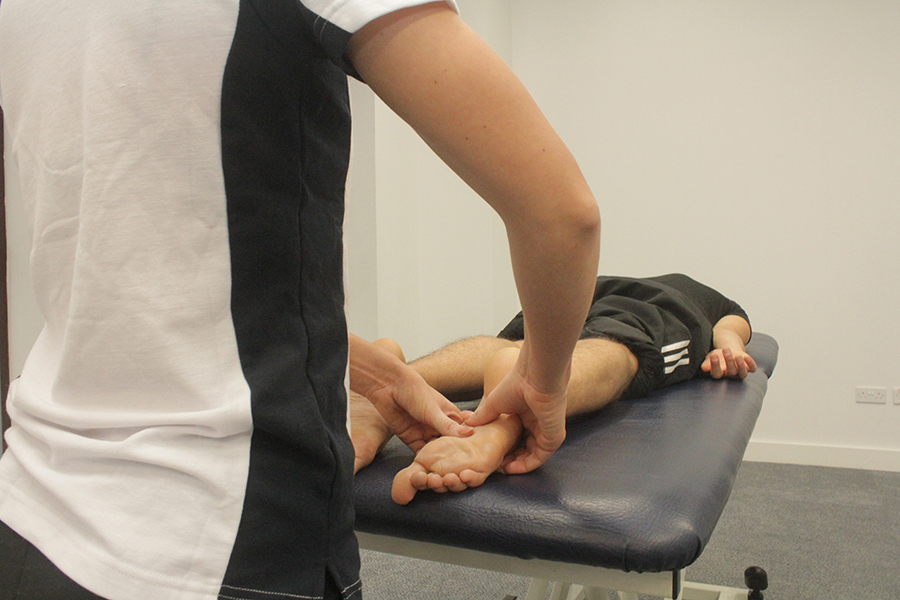Heel spur
A heel spur is a piece of bone that sticks out of the heel bone (the calcaneus). Heel spurs can cause a lot of pain, particularly when pressure is applied to the heel. This means that everyday activities such as standing and walking can be extremely uncomfortable.
What is a heel spur?
A heel spur is a bony projection that forms underneath the heal bone.
Contrary to popular belief, heel spurs are not spiked in shape, however due
to the angle of the X ray pictures taken this is how they appear. As a
result people are misled into thinking that the pain caused by a heel spur
is a result of the spur 'sticking' into the overlying structures. The main
cause of pain associated with heel spurs is actually thought to be
attributed to inflammation, due to nerves in the heel being irritated by
the heel spur.
Heel spurs are associated with plantar fasciitis, however the two are
separate conditions and should not be confused.
A heel spur is the result of too much pressure being placed on the plantar
fascia (a strong band that attaches at the heel and helps to support the
arch of the foot). A person may have plantar fasciitis without having a
heel spur, however the longer a person has had plantar fasciitis (without
treatment) then the more likely they are to have a heel spur. Consequently,
heel spurs are associated with chronic plantar fasciitis.

What causes a heel spur?
A heel spur occurs in some people who have plantar fasciitis, particularly
those who have had plantar fasciitis for a while. Plantar fasciitis is
associated with the development of a heel spur because plantar fasciitis is
caused when too much pressure is placed on the plantar fascia (a thick
fibrous band that attaches at the heel and helps to support the arch). The
symptoms of plantar fasciitis are pain and inflammation at the heel bone
attachment, which causes damage to the bone. Overtime the body tries to
repair the damage, which it does by creating more bone. The result is a
bony projection known as a heel spur.
Some people are more at risk of developing a heel spur than others, they
include those who have/are:
- Overweight
- Flat feet
- High arches
- Over-pronating
- Unsuitable footwear (e.g. footwear with no shock absorption, little support etc)
- Tight calf muscles
What are the signs and symptoms of a heel spur?
The signs and symptoms of a heel spur may include:
- Localised tenderness and pain. The pain is:
- Sharp
- Relieved by rest
- Worse in the morning, when you first get out of bed
- Worse when standing or when pressure is applied to the underside of the heel
- Swelling
- Plantar fasciitis
How is a heel spur diagnosed?
A podiatrist will be able to diagnose a heel spur based on a history, the signs and symptoms and an examination of the heel. There are lots of conditions that can cause pain at the heel, it is therefore important to visit a professional so that the correct treatment can be provided.
Benefits of podiatry for a heel spur
If you have a heel spur Chiropody.co.uk can help you. The following benefits can be achieved following podiatric assessment, advice and treatment:
- Improvement in pain
- Reduction in inflammation
- Improvement in foot function
- Decrease in muscle tightness
What would podiatry for a heel spur involve?
Podiatry for a heel spur would begin by obtaining a medical history as well as a history of the problem itself. The podiatrist will then use this information, along with the signs and symptoms and an examination of the foot and heel to form a diagnosis. Once a diagnosis of a heel spur has been made, the following treatment options may be recommended, the aim of which is to reduce any inflammation and irritation:
- Anti-inflammatory advice
- Orthoses
- Silipos
- Footwear review
- Stretching Programmes
- Heel cups

Summary
A heel spur is a piece of bone that sticks out of the heel. Heel spurs are
associated with plantar fasciitis. Plantar fasciitis produces inflammation
of the plantar fascia (a thick fibrous band that helps to support the arch)
at its attachment at the heel bone, and this can cause damage to the bone.
The bones response to damage is to produce more bone in an attempt to heal
itself (just like when a bone is broken, the body produces more bone in
order to fix the break), which is a normal response to injury. However in
the case of plantar fasciitis the result is a bony projection, otherwise
known as a heel spur.
The pain associated with a heel spur isn't caused by the bone sticking into
overlying tissue, instead it is thought to be caused by inflammation and
irritated nerves in the heel.
If you think you might have a heel spur, visit one of our podiatrists who
will be able to help. They will be able to devise a treatment plan that
will aim to relieve any painful symptoms caused by the heel spur, allowing
you to continue with your activities of daily living comfortably.
To arrange an assessment with one our podiatrists please email office@chiropody.co.uk or call 0330 088 4222.
Save 5% by booking an appointment online.



We work with:

Individuals

Organisations

Health professionals
Get in Touch!
0330 088 4222
If you would like to speak to one of our specialists then please complete this form.
We are open 7 days a week








